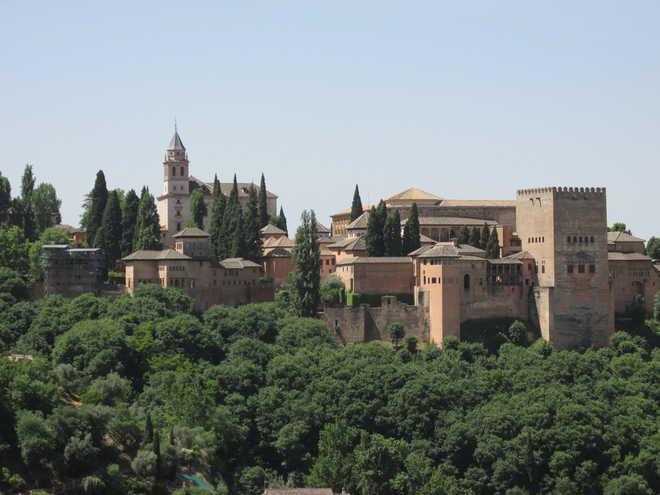
The majestic fort city of Alhambra Photos by the writer
Ranjita Biswas
It’s the pomegranate that has given this historic city its name — Granada in Spain’s southern region of Andalusia. The fruit, ‘granada’ in Spanish language, actually arrived here with the Moors, the Arab race from Morocco that held sway over the Iberian peninsula comprising Spain and Portugal for around 800 years.
Granada’s famous son poet Frederico Garcia Lorca wrote that the pomegranate is hard and skull-like on the outside but on the inside, it contains “the blood of the wounded earth”. With the backdrop of the Sierra Nevada mountains, Granada perpetuates a sense of travelling back to medieval times. To absorb and enjoy the ambience of Granada, a little familiarity with its history helps.
Granada has been continuously inhabited for at least 2,500 years. Celts, Greeks, Romans, Visigoths — all ruled here during different times. But it was the Moorish conquest in 711 ushering in Islamic rule that made Granada an important city in Al-Andalus, as the Muslims named the region. The Nasrid dynasty had a profound influence on its architecture, food and living style. In 1238, Muhammad ibn al Ahmar established a dynasty that saw the development of Alhambra, the most famous landmark of Granada. As the Catholic kings later launched Reconquest with active support of the Papacy, Muslim town after town fell in Andalusia. The last one to go was Granada in 1492 ending the Hispano-Muslim civilisation.
There was a time when under the Moors Jews, Christians and Muslims lived together and thrived in this region. Art and commerce flourished and the Caliphs built the wonderful fort-city Alhambra (Arabic for ‘the red’ due to its red walls) in the al-Sabika hill on the bank of the river Darro so that they could enjoy a salubrious temperature. It was indeed an achievement to build something out of nothing; no one lived here due to lack of water before the Sultans started building the palace in 1237 extending an old fort. With their knowledge of horticulture and drawing water from the river by channels, they greened the bare hills. A great example of their skill is the Generalife (architect’s garden), a summer retreat which, along with the Alhambra, are Unesco World Heritage Sites. By the time the Sultans transformed it to a green abode amid the craggy hills, more than a thousand people lived here. It was a privilege to live within the walled city because everything was available for a comfortable living.
A walk around the expansive compound proves it to be true. Different Muslim rulers extended the palaces but each new section followed the theme of ‘paradise on earth’. Arcades, fountains and reflecting pools with hedges of myrtles, they introduced added to the aesthetics. While the exterior was left plain and austere, inside it was another world, painted richly in blue, red, and golden yellow. It was as if the sultans knew it was the last stronghold of their long stay in Spain and wanted to leave something behind to remember by.
There was a liberal use of white Macael marble available in the region. You can see remnants of hamams — luxurious baths with provision for hot and cold water. Exquisitely pattered walls in alabaster looking like filigree-work, stalactite ceiling decoration (muqarnas), holy script writings in calligraphy, courtyards with water body reflecting the arcade that reminds of the approach to the Taj Mahal, a marble lion square with fountain , there are endless things to discover and appreciate in this palace. Even the Christian kings did not destroy all the beautiful artistry. After the Reconquest liberal King Peter I of Sevilla invited, through the Sultan, craftsmen from Alhambra to decorate his new palace. Mudejar art, a fusion of Islamic and Christian art, developed many examples of which you can see in the Alhambra. For a long time, Alhambra remained isolated. Then American author Washington Irving stayed in Granada for three months in 1829 and on return wrote a book, The Tales of Alhambra which stoked interest of travellers. Today around 2.7 million visitors come here annually. In the high season, serpentine queues are to be expected. For visiting the Nasrid palace, only 300 passes are given at a time. So it is advisable to purchase tickets ahead, which specify the time allotted for each visitor.
Another Unesco heritage site Albaycin lies on the opposite hill across the Daro Valley. This used to be the Muslim residential quarter. Under the Sultanate, around 40,000 people lived here and there were 30 mosques. Though Christians later moved into the houses, they still retained their Moorish character fused with Andalusian architecture. The numerous courtyards with fountains (you can still drink from the taps) the edifices are like picture-postcard of the past. In some houses, tapas bars have cropped up. If you order a drink, the tasty tid-bits from the tapas platter are served free. Try Mosto, a local grape wine without alcohol.
The narrow Calderería Nueva street leading down to the city’s main roads is a delightful area for shopping and have tea in traditional Moorish tea rooms. The air is vibrant and full of people and tourists. This region is famous for authentic flamenco dance. So it’s a good idea catch a show before saying farewell to this wonderful city.
Fact File
How to get there: By air, railways from Madrid or Barcelona but many prefer taking a bus tour from Malaga
Where to stay: There are hotels to suit all budgets — from luxury to youth hostels.
What to do: Go for walking tours of Alhambra and Albaicin. Don’t miss the flamenco show.
What to eat: Visit tapas bars to taste local food.
What to buy: Ceramic tiles, Arabian coffee, colourful bags, shoes and souvenirs.



























